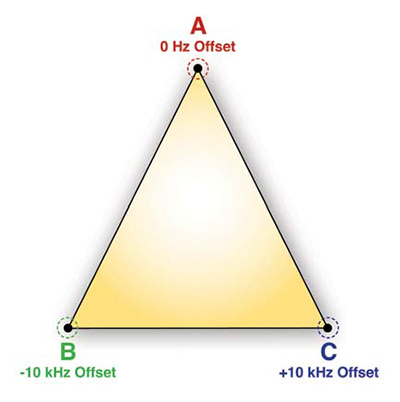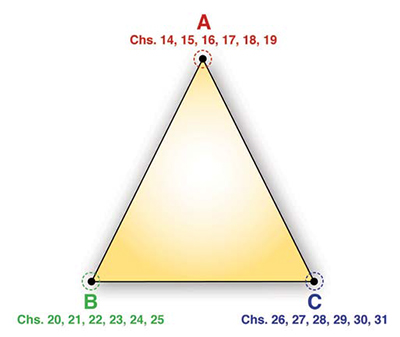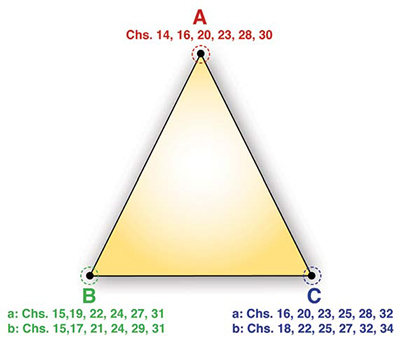Minimizing DTV Interference After Channel Repacking

Charles W. Rhodes
Last month we discussed the restrictions that the FCC must work under in repacking UHF broadcast spectrum. This month, I will venture out on a limb and show how it could be done under those restrictions in a way that minimizes interference to ATSC reception after the Great Repacking. No, I don’t know anything about how the FCC plans to repack. I’ll start from the beginning.
Before most of you were born, the FCC introduced frequency offsets of the visual carriers of TV stations to minimize the visibility of co-channel interference (CCI). The beat between analog TV signals is the difference in visual carrier frequencies. If these beat frequencies were to change so that the beat, while still audible, would apparently vanish, they would reappear with a slight additional change in the frequency offset.
Imagine three cities approximately 100 miles apart. At times, their reception of analog TV was marred by CCI. The FCC set offsets at –10,000 Hz, zero Hz and +10,000 Hz between visual carrier frequencies of the stations comprising trios (Fig. 1a). The beats went away with the introduction of visual carrier frequency offset. Sadly, offsetting of the ATSC pilot carriers has no effect on DTV reception. This was proved at the ATSC in 1995.
FIRST ATTEMPT
Let’s revisit those three stations (A, B and C) now transmitting ATSC signals. With all DTV systems, CCI and adjacent channel interference (ACI) have the nasty effect of blocking reception of picture, sound and data. The viewer sees a flat blue field, and hears nothing. No clue is provided.

Figure 1a: Frequency offset of visual carriers to minimize co-channel Interference between analog TV signals

Figure 1b: Channel offset to eliminate co-channel Interference, DTV-DTV One way to repack the TV spectrum would be to create blocks of contiguous channels (Fig. 1b). The first block of contiguous channels is allocated to the community with station A. The second block of contiguous channels is allocated to the community with station B, and the third block is allocated to the third city in this trio.
If the UHF TV band is reduced to 18 or more channels, each community could have up to six UHF channels. With digital transmission standards there would be no CCI. But we’ve just made ACI worse. This block of six contiguous channels will overload some receivers and reception would fail due to the fact that the NTIA-approved converter boxes and modern DTV receivers we have tested are not perfectly linear. They generate third-order intermodulation (IM3) products when overloaded.
Take Block A for example—Channels 14, 15, 16, 17, 18, 19 and 20. Each contiguous pair of channels could be subject to ACI. But the FCC regulates ACI, so perhaps there won’t be a problem.
Now consider the plight of Channels 15– 19. Ch. 15 gets ACI from Chs. 14 and 16. The sideband splatter (noise) power dumped into receivers tuned to Ch. 15 increases by up to 3 dB. A 3 dB increase in the signal power at the mixer input would result in a 9 dB increase in third-order distortion products except that all NTIA-approved converter boxes and modern DTV receivers we have tested have wideband RF automatic gain control (AGC). This sort of RF AGC was known in the mid-1930s in high-end “all wave radios,” but never used in TV receivers until recently.
The second signal forces the gain of the RF amplifier to decrease in order to hold the total signal power at the mixer constant. This is no coincidence; there is no known alternative to wideband RF AGC to meet the FCC specifications regarding ACI.
So I believe all ATSC receivers will continue to have some form of wideband RF AGC. However to make this scheme work all transmitters serving a given community should be co-sited. Are all transmitters co-sited? In some communities the answer is “yes,” but it is “no” elsewhere and the elsewhere will not want to be moved to an antenna farm.
So why does this scheme require co-siting? It is the age-old near/far problem. A station received from afar puts a weak signal into the receiver, while a transmitter close to the receiving site on an adjacent channel may overload the receiver because the undesired signal (U) is too strong relative to the desired (D) signal; the D/U is too negative for the receiver to work.
Transmitters not now co-sited present a formidable set of problems. Perhaps there is a way around this co-siting problem.
SECOND ATTEMPT
My second try allocates blocks as follows: Community A gets Channels 14, 17, 20, 23, 26 and 29. Community B of this trio of communities gets Channels 15, 18, 21, 24, 27 and 30. The third member of this trio gets Channels 16, 19, 22, 25, 28 and 31 as shown in Fig. 2. Farewell to ACI. But consider now that while we have avoided both CCI and ACI, there is still the taboo channel interference problem.
The FCC’s Sixth Report and Order said that taboo channel interference to DTV reception was almost impossible so it is not covered by commission rules. This is why FCC/ OET Bulletin # 69 says nothing about TCI.

Figure 2: Two examples (a & b) of staggered channel blocks to reduce noise Interference between DTV signals For example, consider Channels 16 and 19. A third-order intermodulation product they may generate in an overloaded receiver falls upon Channel 22. Did I say overloaded receiver? Yes, unless these transmitters are co-sited, the near/ far problem may exist at some residential sites within this community.
This problem can be solved with co-siting as our experiments with both converter boxes and with modern ATSC receivers have shown. The term “co-siting” can have several meanings. Ideally it means the same site, the same tower and the same antenna.
I believe the FCC considers two stations to be co-sited if their towers are less than 8 km apart. But interference could also be mitigated by reducing the number of third-order products that fall within the UHF spectrum after repacking. This means staggering these channels. If the UHF TV spectrum after repacking is Channels 14–32 the lowest IM3 = 2*14 – 32 = Ch. –4, which doesn’t exist.
The highest IM3 is 2*32–14 = Ch. 50, which will no longer be a TV channel. With triple beats (TB)—the other form of third-order distortion, and by far the most potent source of interference when there are six signals—the lowest TB = 14 + 15 – 32 = –3. No problem. The highest TB is 31 + 32–14 = Channel 49, which no longer exists as a TV channel.
Stanley Knight, a regular reader of this column, has contributed to our research on this problem. Table 1 by Mr. Knight shows two of the many combinations of channels that are non-uniformly staggered. This table explains what I mean by staggering the channels of a block.

Table 1: Staggered Channel Plans A and B There are many staggered combinations of channels to be considered. Minimizing the noise in the locally used bock of channels is the name of the game. Knight is working on software to do just that.
The noise in a given channel consists of IM3 and TB. Both of these third-order distortion products occupy three contiguous channels. Each side channel is given a weight of 1. The center channel of an IM3 is given a weight of 4. Each TB is weighted 10 while its side channels are weighted 2.5. These weighted sums for each local channel are added and compared to alternative staggering schemes to find the least noise for each channel. That is a work in process.
What I find exciting is that I believe this scheme complies with the constraints imposed by Congress in its 2012 legislation to authorize the FCC to auction spectrum. I would like to hear from broadcasters and their consulting engineers about this scheme, or about alternatives to it. I do not intend to propose this or any other scheme to the FCC. Only stakeholders should address this matter, I believe.
Stay tuned.
Charles Rhodes is a consultant in the field of television broadcast technologies and planning. He can be reached via e-mail atcwr@bootit.com.
Get the TV Tech Newsletter
The professional video industry's #1 source for news, trends and product and tech information. Sign up below.
